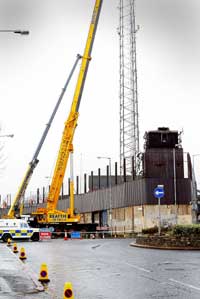27 January 2005 Edition
Goodbye and good riddance to PSNI barracks

Up to 150 republicans gathered at Andersonstown PSNI Barracks in West Belfast on Sunday last to greet the closure of a building that has stood as a symbol of the British military oppression of nationalists for over 100 years.
As a press conference got under way inside the barracks, with senior PSNI members extolling the merits of RUC and PSNI operations in the area, up to 50 of the demonstrators invaded the barracks.
Standing in the forecourt of the paramilitary base, the protesters brought their message of collusion into a building from where the killers of IRA Volunteer Pearse Jordan set out in 1992. Jordan was unarmed when members of an RUC undercover unit ambushed and him shot dead on the Falls Road, just hundreds of yards from the barracks, in 1992.
Fian John Dempsey was shot dead on the morning of 8 July 1981, within hours of the death of Hunger Striker Joe McDonnell, when British soldiers secreted in the Falls Road bus depot ambushed him. The British unit was almost certainly based in Andersonstown barracks and set up their ambush on the unarmed Dempsey just yards from the barracks.
Welcoming the closure of the barracks, Hugh Jordan, Pearse's father, said it had been a constant reminder of what happened.
Huge spy towers
Not alone was the barracks a physical symbol of British oppression, it was also the eyes and ears of the crown forces. Its huge spy towers overlooked Milltown Cemetery when loyalist Michael Stone killed three mourners attending the funerals of Volunteers Mairéad Farrell, Dan McCann and Seán Savage, shot dead by the SAS in Gibraltar in March 1988.
Loyalist attacks on the homes of Sinn Féin President Gerry Adams and former councillor Joe Austin and the shootings at the Kennedy Way cleansing depot, where two workers were shot dead, were carried out under the gaze of the barracks spy towers, yet the attackers escaped with impunity.
The barracks officially closed at 5.30pm on Sunday 23 January, and work to demolish it is due to begin in the middle of February.
Constant delays
Gerry Adams, commenting on the closure, said "this blot on the landscape of West Belfast should have been closed a long time ago. Its existence is a constant reminder of the depths to which the state will go to oppress a local community. And the constant delays in agreeing its closure is evidence of the refusal of securocrats within the British system and in the PSNI to the necessary process of demilitarisation.
"This paramilitary Barracks stands on an important junction in West Belfast and the land should now be made available to the local community to use for a project or projects which can make a positive contribution to the life of this area."
• Meanwhile, Sinn Féin councillor for the Short Strand area of East Belfast, Joe O'Donnell has welcomed the news that Mountpottinger PSNI base in the middle of the Short Strand is one of up to ten PSNI bases set to close.
The barracks, which dominates the small nationalist enclave, began life as an RIC barracks and has long been a blight on the lives of Short Strand residents. Numerous republicans taken into custody by the RUC would have been brought to Mountpottinger before being transferred to the notorious Castlereagh interrogation centre.
Opened fire
In December 1983, an RUC man leaving the base opened fire on three nationalist youths at the junction of Thompson Street, shooting 18-year-old Tony Dawson dead.
Said Joe O'Donnell: "The maintenance of Mountpottinger barracks has been a constant reminder to the local community of the official state policy of keeping the croppies in their place. If nationalist areas are to benefit from the Peace Process, then military installations such as Mountpottinger need to be removed."
O'Donnell called for a social housing scheme on the site of the barracks "to alleviate the serious housing shortage in the Short Strand".



